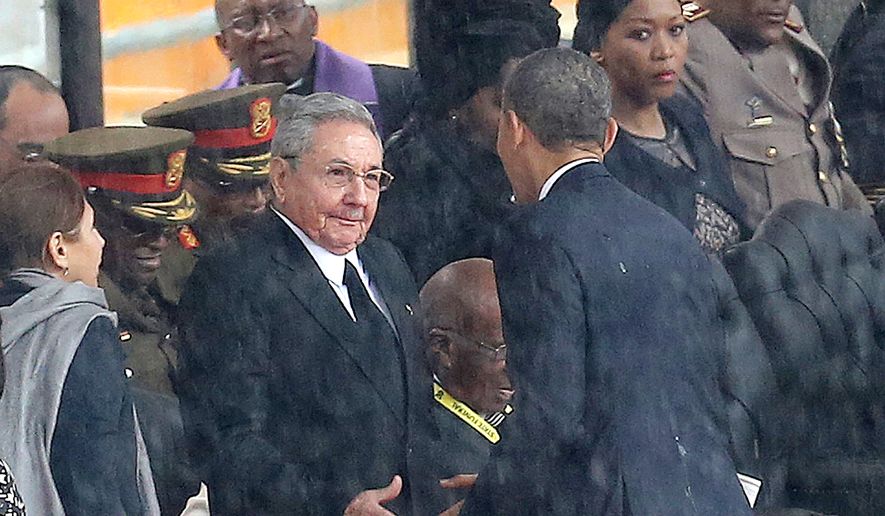Reversing more than 50 years of U.S. policy, President Obama Wednesday announced the resumption of diplomatic relations with Cuba, hailing it as “a new chapter” with the Communist-controlled nation.
“We will begin to normalize relations between our two countries,” Mr. Obama said from the White House. “These 50 years have shown that isolation has not worked.”
As he spoke, Cuban leader Raul Castro was addressing his country about the developments.
After 18 months of secret meetings and a personal appeal from Pope Francis, the Obama administration announced the historic agreement with Cuba, a seismic shift predicated on the release of American Alan Gross after five years in captivity.
Administration officials say the U.S. will begin immediately to open an embassy in Havana, will review Cuba’s status as a sponsor of terrorism, will open up trade and business opportunities between the two nations and take other steps to turn back a policy that has been in place since the Kennedy era.
Mr. Obama said five decades worth of sanctions against the Cuban regime have had “little effect.”
“We cannot keep doing the same ting over five decades and expect a different result,” Mr. Obama said.
The deal for Mr. Gross’ release involved the exchange of three Cuban agents held in the U.S. and also the release of a U.S. intelligence agent who had been held in Cuba for more than 20 years.
“This man is now safely on our shores,” Mr. Obama said of the operative.
The overhaul in relations comes as the Cuban government released American aid worker Mr. Gross, who had been held in Cuba five years.
Administration officials said Cuba’s agreement to release the U.S. intelligence “asset” in exchange for the release of three Cubans held in the U.S. on espionage charges since the late 1980s was separate and apart from Cuba’s decision to release Mr. Gross on humanitarian grounds. It’s unclear whether the asset is an American citizen.
Administration officials say they began high-level secret talks with the Cuban government in the spring of 2013. A series of meetings were held in Canada, though the Canadian government did not participate.
The thaw in relations neared the finish line this fall, when the two governments met at the Vatican. Officials say the Vatican, and Pope Francis in particular, played a key role in bringing the sides to the negotiating table.
The pontiff personally sent letters to both Mr. Obama and Cuban Raul Castro urging for normalization of ties, officials said.
“Pope Francis decided to make a personal appeal, which is very rare,” an administration official told reporters Wednesday. “That gave greater impetus and momentum for us to move forward.”
On the broad implications of Wednesday’s move, officials say it will serve as a “transformative event” for the U.S. and its relations with Latin America, where many nations have strongly objected to American isolation of the communist island.
“The rest of the world has moved on from this set of policies, and I believe this will be good for the United States,” an administration official said.
Mr. Obama said the U.S. will establish an embassy in Cuba and take steps to boost trade and tourism with Havana. The president said it no longer makes sense to keep sanctions in place against a regime that hasn’t toppled despite U.S. efforts dating back to 1961.
“Today, Cuba is still governed by the Castros and the Communist Party that came to power half a century ago,” Mr. Obama said. “Neither the American nor Cuban people are well-served by a rigid policy that’s rooted in events that took place before most of us were born.”
The president said the U.S. has had diplomatic relations with China, “a far larger country also governed by a Communist Party,” for more than 35 years. He also noted that the U.S. reestablished relations nearly 20 years ago with Vietnam, “where we fought a war that claimed more Americans than any Cold War confrontation.”
U.S. intelligence officials said the other man released from Cuban custody is a Cuban national who provided “critical assistance” to the United States.
“Information provided by this person was instrumental in the identification and disruption of several Cuban intelligence operatives in the United States and ultimately led to a series of successful federal espionage prosecutions,” said Brian Hale, spokesman for the Director of National Intelligence.
The agent provided the information that led to the identification and conviction of Defense Intelligence Agency senior analyst Ana Belen Montes; former State Department official Walter Kendall Myers and his spouse Gwendolyn Myers; and members of the Red Avispa network, or “Wasp Network,” in Florida, which included members of the so-called “Cuban Five,” Mr. Hale said.
“In light of his sacrifice on behalf of the United States, securing his release from prison after 20 years — in a swap for three of the Cuban spies he helped put behind bars — is fitting closure to this Cold World chapter of U.S.-Cuban relations,” he said.
• Dave Boyer can be reached at dboyer@washingtontimes.com.




Please read our comment policy before commenting.